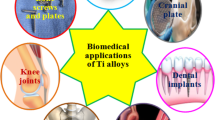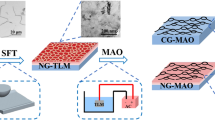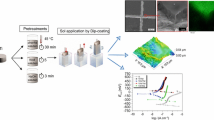Abstract
This paper describes a simple, facile, low-cost method of fabricating a wear-resistant surface on titanium alloy substrates by single-step anodization and modification with silicon dioxide particles. The method produced a TiO2–SiO2 composite surface with micro- to nanohierarchical structure, which became multifunctional after fluoroalkylsilane modification. The surface not only showed excellent superhydrophobicity [contact angles (CAs) > 150°, sliding angles (SAs) ≤ 8°] but also exhibited better repellency of complex whole blood (CAs = 153° ± 2°, SAs = 9°). Furthermore, the wear resistance of the surface was investigated by sandpaper abrasion test. The results showed that the mechanical wear resistance of the TiO2–SiO2 composite surface was more than three times that of the surface prepared only by the electrochemical technique, and the surface still maintained the capacity of hydrophobicity even after 33.6 m of wear under conditions of 3400 Pa and 360# sandpaper. The method mentioned in this paper could be a candidate for the production of abrasion-resistant and super-repellent titanium alloy.
Graphical Abstract








Similar content being viewed by others
References
Fürstner R, Barthlott W, Neinhuis C, Walzel P (2005) Wetting and self-cleaning properties of artificial superhydrophobic surfaces. Langmuir 21(3):956–961
Vakarelski IU, Patankar NA, Marston JO, Chan DY, Thoroddsen ST (2012) Stabilization of Leidenfrost vapour layer by textured superhydrophobic surfaces. Nature 489(7415):274–277
Boinovich LB, Emelyanenko AM (2013) Anti-icing potential of superhydrophobic coatings. Mendeleev Commun 23(1):3–10
Shen Y, Tao H, Chen S, Zhu L, Wang T, Tao J (2015) Icephobic/anti-icing potential of superhydrophobic Ti6Al4V surfaces with hierarchical textures. RSC Adv 5(3):1666–1672
Kota AK, Choi W, Tuteja A (2013) Superomniphobic surfaces: design and durability. MRS Bull 38(05):383–390
Ou J, Hu W, Liu S, Xue M, Wang F, Li W (2013) Superoleophobic textured copper surfaces fabricated by chemical etching/oxidation and surface fluorination. ACS Appl Mater Interfaces 5(20):10035–10041
Xue C-H, Li Y-R, Zhang P, Ma J-Z, Jia S-T (2014) Washable and wear-resistant superhydrophobic surfaces with self-cleaning property by chemical etching of fibers and hydrophobization. ACS Appl Mater Interfaces 6(13):10153–10161
Wang F, Luo H, Wang Q, Wang J, Xu J (2009) Preparation of superhydrophobic polymeric film on aluminum plates by electrochemical polymerization. Molecules 14(11):4737–4746
Wang D, Wang X, Liu X, Zhou F (2010) Engineering a titanium surface with controllable oleophobicity and switchable oil adhesion. J Phys Chem C 114(21):9938–9944
Li H, Liao J, Du Y, You T, Liao W, Wen L (2013) Magnetic-field-induced deposition to fabricate multifunctional nanostructured Co, Ni, and CoNi alloy films as catalysts, ferromagnetic and superhydrophobic materials. Chem Commun 49(17):1768–1770
Qian B, Shen Z (2005) Fabrication of superhydrophobic surfaces by dislocation-selective chemical etching on aluminum, copper, and zinc substrates. Langmuir 21(20):9007–9009
Huang Z, Geyer N, Werner P, De Boor J, Gösele U (2011) Metal-assisted chemical etching of silicon: a review. Adv Mater 23(2):285–308
Cui H, Yang G, Sun Y, Wang C (2010) Reversible ultraviolet light-manipulated superhydrophobic-to-superhydrophilic transition on a tubular SiC nanostructure film. Appl Phys Lett 97(18):183112
Yf G (2014) SiO2/TiO2 composite aerogels: preparation via ambient pressure drying and photocatalytic performance. Ceram Int 40:13781–13786
Hahn R, Macak J, Schmuki P (2007) Rapid anodic growth of TiO2 and WO3 nanotubes in fluoride free electrolytes. Electrochem Commun 9(5):947–952
Berger S, Macak JM, Kunze J, Schmuki P (2008) High-efficiency conversion of sputtered Ti thin films into TiO2 nanotubular layers. Electrochem Solid-State Lett 11(7):C37–C40
Liang J, Liu K, Wang D, Li H, Li P, Li S, Su S, Xu S, Luo Y (2015) Facile fabrication of superhydrophilic/superhydrophobic surface on titanium substrate by single-step anodization and fluorination. Appl Surf Sci 338:126–136
Barthwal S, Kim YS, Lim S-H (2013) Fabrication of amphiphobic surface by using titanium anodization for large-area three-dimensional substrates. J Colloid Interface Sci 400:123–129
Lu Y, Song J, Liu X, Xu W, Xing Y, Wei Z (2012) Preparation of superoleophobic and superhydrophobic titanium surfaces via an environmentally friendly electrochemical etching method. ACS Sustain Chem Eng 1(1):102–109
Huang Q, Yang Y, Hu R, Lin C, Sun L, Vogler EA (2015) Reduced platelet adhesion and improved corrosion resistance of superhydrophobic TiO2-nanotube-coated 316L stainless steel. Colloids Surf B 125:134–141
Ebert D, Bhushan B (2012) Transparent, superhydrophobic, and wear-resistant coatings on glass and polymer substrates using SiO2, ZnO, and ITO nanoparticles. Langmuir 28(31):11391–11399
Tang Y, Yang J, Yin L, Chen B, Tang H, Liu C, Li C (2014) Fabrication of superhydrophobic polyurethane/MoS2 nanocomposite coatings with wear-resistance. Colloids Surf A 459:261–266
Su C, Xu Y, Gong F, Wang F, Li C (2010) The abrasion resistance of a superhydrophobic surface comprised of polyurethane elastomer. Soft Matter 6(24):6068–6071
Zhu Q, Chu Y, Wang Z, Chen N, Lin L, Liu F, Pan Q (2013) Robust superhydrophobic polyurethane sponge as a highly reusable oil-absorption material. J Mater Chem A 1(17):5386–5393
Kartini I, Santosa SJ, Febriyanti E, Nugroho OR, Yu H, Wang L (2014) Hybrid assembly of nanosol titania and dodecylamine for superhydrophobic self-cleaning glass. J Nanopart Res 16(7):1–14
Mittal KL (2007) Silanes and other coupling agents, vol 4. CRC Press, Florida
Min K, Gao H, Matyjaszewski K (2005) Preparation of homopolymers and block copolymers in miniemulsion by ATRP using activators generated by electron transfer (AGET). J Am Chem Soc 127(11):3825–3830
Lee H, Scherer NF, Messersmith PB (2006) Single-molecule mechanics of mussel adhesion. Proc Natl Acad Sci U S A 103(35):12999–13003. doi:10.1073/pnas.0605552103
Kang SM, You I, Cho WK, Shon HK, Lee TG, Choi IS, Karp JM, Lee H (2010) One-step modification of superhydrophobic surfaces by a mussel-inspired polymer coating. Angew Chem 49(49):9401–9404. doi:10.1002/anie.201004693
Lian F, Zhang HC, Pang LY, Zhu HB (2012) Effects of surface film on superhydrophobic characteristics of Ti6Al4V with dotted matrix structure. Rare Met Mater Eng 41(4):612–616
Zhang L, Wu J, Wang Y, Long Y, Zhao N, Xu J (2012) Combination of bioinspiration: a general route to superhydrophobic particles. J Am Chem Soc 134(24):9879–9881
Marmur A, Bittoun E (2009) When Wenzel and Cassie are right: reconciling local and global considerations. Langmuir 25(3):1277–1281
Verplanck N, Coffinier Y, Thomy V, Boukherroub R (2007) Wettability switching techniques on superhydrophobic surfaces. Nanoscale Res Lett 2(12):577–596
Sun Y, Wang L, Gao Y, Guo D (2015) Preparation of stable superamphiphobic surfaces on Ti-6Al-4V substrates by one-step anodization. Appl Surf Sci 324:825–830
Acknowledgments
This work was financially supported by the National Basic Research Program of China (2012CB934100).
Author information
Authors and Affiliations
Corresponding author
Rights and permissions
About this article
Cite this article
Li, Q., Tang, F., Wang, C. et al. Facile fabrication of wear-resistant multifunctional surfaces on titanium alloy substrate by one-step anodization and modification with silicon dioxide nanoparticles. J Sol-Gel Sci Technol 80, 318–325 (2016). https://doi.org/10.1007/s10971-016-4088-y
Received:
Accepted:
Published:
Issue Date:
DOI: https://doi.org/10.1007/s10971-016-4088-y




